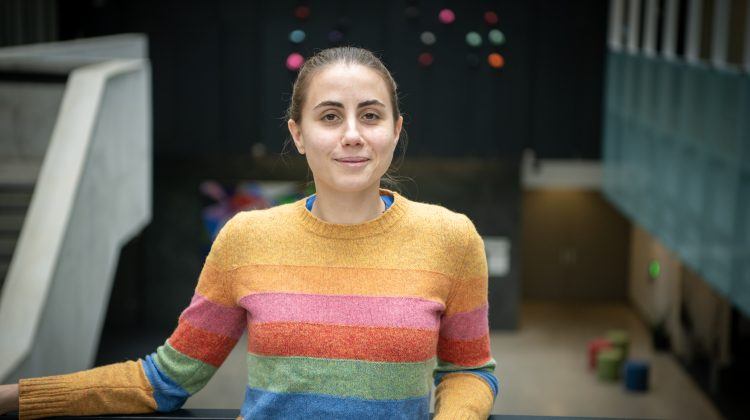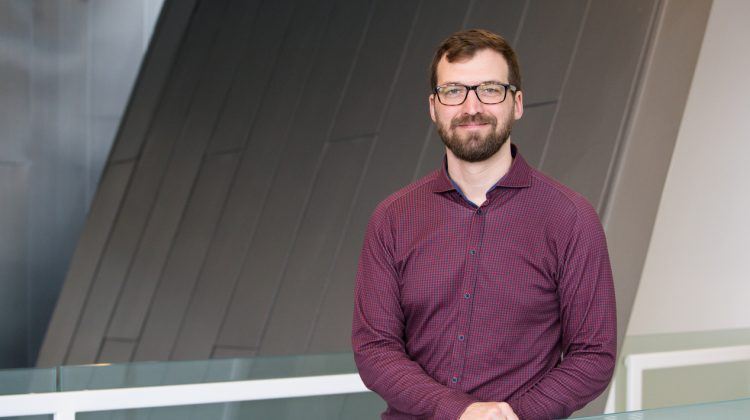Artists who shaped astronomy, then and now
From 19th century astro-sketchers to 21st century image processors, artists and astronomers have worked hand-in-hand for centuries. The results have been out of this world.

In the spring of 1895, full-time school inspector and part-time astronomer James Wadsworth lined up his 12.5-inch reflecting telescope – the largest in Canada at the time – to observe the rings of Saturn. He noted the Cassini Division (a large gap between Saturn’s A and B rings), hints of Saturn’s darker coloured “crepe ring” (named after the dark cloth worn by Victorians during periods of mourning), and the motion of the planet’s larger moons. But something puzzled him. The shadow Saturn cast on its rings bent inward with an oddly concave shape, rather than following the curve of the globe.
Wadsworth had just made a “discovery” that, when examined by his colleagues, would turn out to be a red herring: a dead end. It ended up relegated to the dustbin of history, a mere footnote in the astronomical record.
But the event is important for a different reason: It reveals that in 19th century science, artists acted as the glue that bound the global astronomical community together. They were part of the connective tissue that enabled collaboration and peer review. When Wadsworth discovered his anomaly, he needed a way for his colleagues to corroborate – or, as it turned out, refute – his findings.
So he recruited an artist.
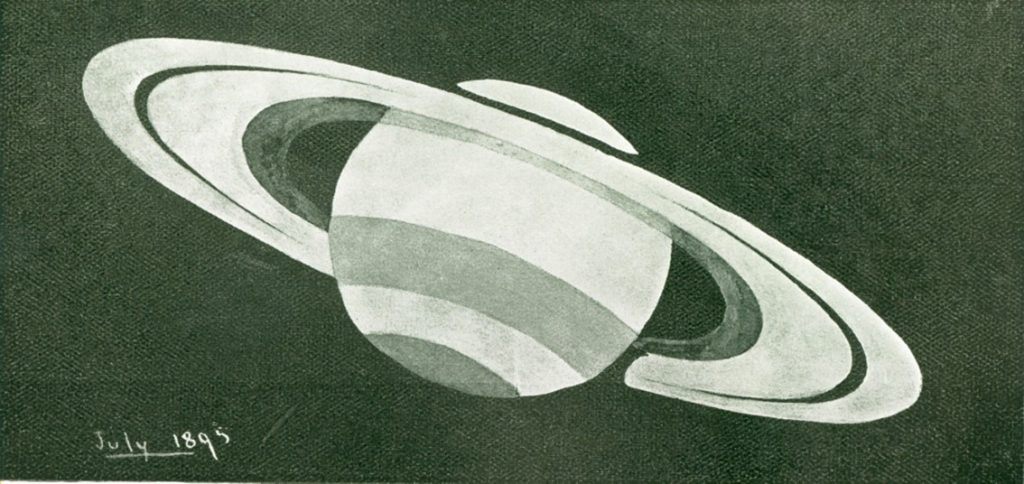
Of course, he could have tried photography: the first photographs of Saturn had been taken a decade earlier in 1885-6 by Paul and Prosper Henry, an inseparable pair of Parisian brothers who collaborated on astronomical endeavours. But early photographs were unreliable, and only supplemented, rather than replaced, astronomical sketches. Distant objects became blurry in daguerreotype photography, while sketches could recreate minute details seen by the eye, limited only by the talent of the artist.
Consequently, artistic expertise was a vital, central part of astronomy in 1895.
The surprising thing is that art has remained central to astronomy even in the present day. Though techniques and technology have changed, modern astronomers share a common artistic heritage with their Victorian counterparts, seeking balance between the subjectivity of art and the rigour of science. It is a conundrum Wadsworth faced more than a century ago, yet it remains more familiar than alien to astronomers today.
Back in 1895, Wadsworth solved his problem by turning to a painter – one with considerable talent. Born in Simcoe, Ontario, Eva Brook was a fine arts graduate of Alma College in St. Thomas (where she later returned as head of the Art department). She had studied in New York and would later settle in Mexico, training with masters at San Carlos Academy. Her career saw her featured in major exhibits across North America, and her water colours and oils garnered international renown.
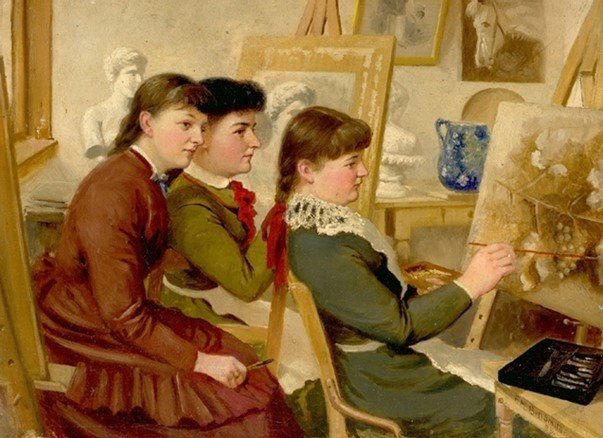
In July, Brook sat down with Wadsworth to sketch his shadowy anomaly. Her drawing of Saturn appeared in the 1895 Transactions of the Astronomical and Physical Society of Toronto (the Society later became the Royal Astronomical Society of Canada, or RASC). The concave shadow she drew caught the attention of many of the Society’s members, including its vice president, Arthur Harvey. Harvey pointed his own 3-inch telescope at Saturn and believed he could see the concavity, though at such low resolution he couldn’t be sure.
In August, at a meeting of the Society, Harvey set up a series of models and diagrams to demonstrate that if the shadow’s concavity was real, the rings of Saturn must not be flat. The shape of shadow suggested a “lenticular or elliptical” bulge.
Saturn’s rings were already at the heart of astronomical debate in 1895 (which is probably why Wadsworth was observing the planet in the first place). In April that year, American spectroscopy expert Joseph Keeler had shown that the rings seemed to be made of loose particles, moving faster in the inner rings and slower at the outer edges. They were not solid disks, but free-floating dust, rocks, and ice. Harvey took Brook’s sketch as further evidence of Keeler’s conclusions: there was lumpy, uneven material floating in the rings.
With Saturn in the spotlight among astronomers that year, Brook’s sketch of Saturn found a wide audience. Eventually, it came across the desk of the editors of Science, a major American journal. They began their own investigation into the matter and ultimately concluded it a mere illusion, a trick of the light: “The apparent outline of the shadow will always be greatly influenced by various optical illusions, and observations made with ordinary telescopes under ordinary conditions cannot be safely relied on,” they wrote.
A similar optical illusion had been reported in 1876 and 1878, when Saturn’s rings were seen nearly edge on and therefore appeared very narrow, enabling the illusion of a concave shadow. As the planet tilted on its axis, the rings broadened from Earth’s perspective, and the concavity disappeared. Wadsworth and Brook had probably seen an identical optical anomaly.
In fairness to Wadsworth, today’s scientists and science artists still grapple with illusions. Astronomers must continually edit out light diffractions and other distortions. You can tell, for example, if a photo is from the Hubble Space Telescope or the James Webb Space Telescope (JWST) depending on whether the stars in the foreground have four or eight diffraction spikes – the telescopes’ different mirror shapes cause light patterns that don’t represent any real phenomenon in frame. Even these billion-dollar instruments produce anomalies that are the annoying result of the laws of physics.

Image Credit: Hubble: NASA, ESA, and STScI JWST: NASA, ESA, CSA, and STScI
As for Saturn’s rings, we know now that they are indeed made up of millions of individual particulates, like Keeler predicted, but their arrangement is flat. Very flat. To scale, the rings are thinner than a sheet of paper. The Wadsworth and Brook anomaly was not evidence of a bulging ring.
But it is thanks to the communicative power of art that the possibility was ruled out. In 19th century science, corroborating observations with colleagues was the only way to sieve optical error from astronomical reality. Artists played a key role in enabling the sharing of discoveries and the independent testing of hypotheses.
These artists took their work seriously. The first sketches ever done by telescope preceded even Galileo Galilei, and that centuries-long tradition demanded accuracy from its 19th century practitioners. British astronomer Margaret Huggins wrote in 1882, “in all drawings for scientific purposes nature must be studied with line-by-line faithfulness.”
That, of course, was an ideal. In reality, combining art and science always requires some struggle between subjectivity and objectivity.
Neither art nor science is ever immune from social pressures, either. Astronomy in this period was caught up in a flurry of social change, particularly the struggle for women to participate in science. For some, art acted like a gateway, enabling women to break into the field, launching from artistic careers into scientific ones.
A universe for all: The late 19th century tipping point for women in astronomy
Brook and Wadsworth’s collaboration was more than a one-time affair. They worked together on several occasions, including on a pair of lunar sketches that captured a region of the Moon known as Mare Crisium. Wadsworth used Brook’s lunar drawings to impress on his colleagues how “the skilful artist can represent what the photographic plate cannot show.”
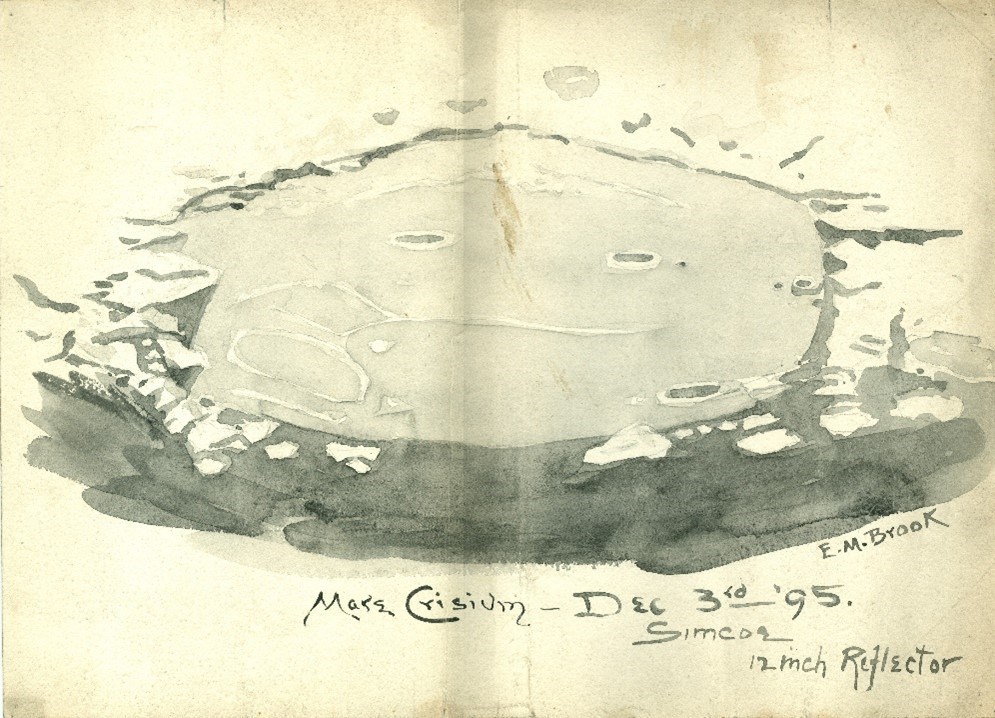
When Brook moved away from Canada to study in Mexico, she left a vacuum in Canadian astro-sketching, but it wasn’t long before new volunteers stepped up. In 1897, two more artists from Simcoe, Ontario, Cora Beemer and Helen Stennett, worked with Wadsworth on a study of lunar features under different phases of illumination. Stennett also created a series of sunspot sketches.
Their exceptional work was recognized by the astronomical community. “Dr. Wadsworth was requested to convey to the ladies the thanks of the Society for these drawings,” read the 1897 Transactions. “It was thought to be a most encouraging sign of the growing popularity of astronomical work when ladies were willing to devote their time to the interesting work of sketching at the telescope.”
Indeed it was. These artists were only one small part of a much larger cultural shift in the late 19th century. Positions for women in astronomy were growing more common, though often still in junior roles. Harvard University had employed a team of talented women computers like Williamina Fleming as early as 1879, and the Royal Observatory at Greenwich did the same in Britain in the early 1890s. In Canada, there were far fewer professional astronomers of any gender (neither Wadsworth nor the artists he worked with were paid), but the amateur organization that would later become the RASC was booming. It had been founded as an offshoot of the Canadian Institute years earlier but had floundered in obscurity for decades before finally finding its footing in 1890.
At the 12th meeting of the reconstituted organization that summer, the meeting minutes indicated that “among the visitors were several ladies, who apparently took a deep interest in the proceedings.”

That interest would grow steadily. By 1895, more than 20 percent of the RASC’s members were women. One of them, Annie Savigny, was particularly active. Already a popular romance novelist, an animal welfare activist with the Toronto Humane Society, and a children’s author, Savigny devoted her remaining free time to astronomy. She carried out lunar sketches and captured the 1897 solar eclipse on paper, as well as observing meteor showers. Savigny even presented papers to the Society about recent observations of Mars, having met with famed American astronomer Percival Lowell and discussed his controversial – but not yet discredited – theories about the presence of canals on the red planet.

Women in astronomy did not merely work at the whims of men like Wadsworth. A note in the 1897 Transactions indicates that Beemer and Stennett, for example, chose for themselves which lunar features to study. What’s more, the RASC as a whole relied on the goodwill of aristocratic women: it leaned, for instance, on the patronage of Lady Emma Wilson, wife of the former mayor of Toronto, who donated a telescope to the Society and sponsored some of its activities.
Brook, Stennett, Beemer, and Savigny’s astro-sketching, therefore, was part of a cultural widening of astronomy, in which women (albeit mostly upper-middle-class women) were making an active space for themselves. They took their place alongside male colleagues like prominent French-American astro-sketcher Étienne Léopold Trouvelot (whose own sketch of Saturn, incidentally, also captures an anomalously crooked shadow on the planet’s rings).
But the world was changing in other ways, too. Photographic techniques kept improving, pushing sketching and painting out of astronomy in slow but steady increments.
Yet photography also requires artistic talent.
If we fast forward to the present day, more than a century later, artistry remains a core piece of astronomy – but image processing has become the new astro-sketching.
Art and astronomy in the 21st century, or how to take a photo with the James Webb Space Telescope
At first glance, there is little similarity between the hand-drawn sketches by pioneering astro-artists like Brook and the stunning images produced by 21st century space telescopes. Yet many of the aims and challenges remain unchanged. There is still an effort to minimize subjectivity, while enabling a global collaborative scientific process.
JWST is a perfect example. In early 2022, the telescope powered on and turned its gaze to the heavens for the first time. Just a few months later, its first spectacular images were released with fanfare. But the images didn’t arrive at the press release fully formed. Between the space telescope and the public eye lay a team of astro-artists.
Alyssa Pagan of the Space Telescope Science Institute was one of them. It is Pagan’s job to turn the space telescope’s raw data into full-colour images.
Just like astro-sketchers a century earlier, the prime directive of modern-day image processing is to capture what is real and bring it to life, without introducing false information.
“The main thing is we’re not adding any data,” says Pagan. “Whatever’s there, we’re using and enhancing it, but we’re not making up features and we’re not over-sharpening these features trying to pretend we’re getting resolution that’s not there. We’re not taking away anything that’s actually intrinsic to the objects in space.”
That said, aesthetics still play a role.
Before getting into Pagan’s hands, JWST images are run through an automated “calibration pipeline.” The pipeline flags bad pixels, cosmic ray hits, oversaturated regions, and other confounding factors. It produces a low-contrast greyscale image containing all the viable data.
Pagan’s role is to bring out the grandeur hidden in those dull pixels. She adjusts the colour and light balance and decides an image’s orientation (up and down don’t matter in space, though Pagan points out that it’s sometimes useful to maintain a standard orientation). One of her first tasks when working with a new image is a process called “stretching,” which enhances the dimmest objects and dims the brightest, enabling all the depth of detail to stand out.
There is a scientific story within each image, and her job is to tell it as best she can.

“For the Carina Nebula, for instance, a lot of the work done on that was to emphasize the two different processes that are happening there – the dense dust region, which is the bright orange dunes, and then the blue gas – and then having an orientation that felt natural to us, like a mountain scape, because that is a parallel to how we see mountains on Earth,” says Pagan. “It’s also a parallel to what’s actually happening: the dust has been eroded by these hot stars, just like on Earth where we have mountains that are being eroded by weathering. Having that contextual understanding is helpful.”
Determining colour is perhaps the trickiest part. JWST uses a series of filters on the spacecraft to capture various wavelengths of light. Near-infrared filters, for example, allow the telescope to peer through clouds of interstellar dust to see young stars being born, while mid-infrared filters give information about dust emissions. There are also filters for wavelengths that can pick up particular chemical signatures, like hydrogen, nitrogen, or oxygen.
But the human eye cannot see in infrared, so Pagan has to shift the wavelengths into the visible range. The longest infrared wavelengths get assigned redder colours, while shorter wavelengths become blue.
This process raises a question about whether it is a “real” colour photo. Pagan characterizes it as interpretation rather than falsification.
“It’s about translating the information that’s really there. Just because we can’t see it doesn’t mean that’s not how our world looks. It’s like an extended way of looking at our reality. Other animals can see in infrared light. We use medical imagery to see our bones in X rays, and to see our soft tissue in MRI machines. That’s not a lie just because we can’t see it,” she says.
One year into its operational lifetime, JWST has already captured many hundreds of stunning new glimpses into our universe. It has found galaxies more distant than ever before and is helping cosmologists revise and refine their models.
This partnership between art and science has also helped inspire a new generation of scientists.
“People connect to these images because they give you a perspective that’s so much greater than yourself. Not in a way that makes you feel insignificant, but in a way that makes you feel a part of something so grand and wonderful and beautiful,” says Pagan. “It helps you understand the universe and therefore understand yourself. I think that’s wonderful.”
Subjectivity and the Event Horizon Telescope, or how to make “images with error bars”
Representations of the universe have come a long way in the last hundred years, and techniques are still changing. Fast. Human astronomers are beginning to collaborate with supercomputers and AI algorithms to produce images that couldn’t possibly be captured otherwise.
Consider radio astronomy: Radio signals are another electromagnetic wavelength of light that the human eye cannot see, but we can detect them with radio receivers. That allows us to interpret astronomical radio emissions and ultimately represent them visually.
The most famous example in recent years is the Event Horizon Telescope (EHT) capturing the first ever image of a black hole.
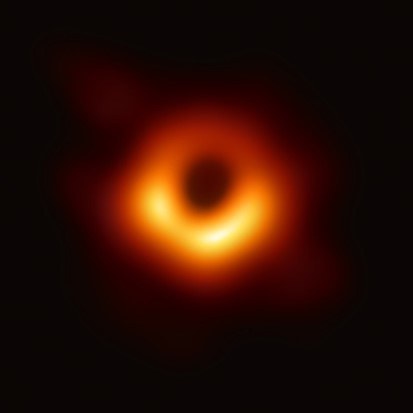
The vibrant colours in the EHT images represent not visible light and colour, but a measure of “brightness temperature”: essentially, a descriptive measure of radiation being emitted. The brightest portions of the accretion disk around the black hole feature higher emissions, with brightness temperatures reaching 6 billion kelvin, while the darker orange regions are somewhat less active.
As a whole, that bright orange death donut is the spectacular result of years of refining astronomical techniques. Although the accretion disks of black holes are among the brightest objects in the universe, they are so distant and so small that Wadsworth’s 12.5-inch telescope couldn’t dream of seeing them, nor could any of today’s largest telescopes.
At least, not by themselves. The EHT’s images are made by synchronizing a network of telescopes around the world, essentially synthesizing a telescope the size of the entire Earth. This method has drawbacks: it doesn’t collect all the light that an actual Earth-sized telescope mirror would – instead it’s just sampling bits and pieces of the light. The challenge, then, is filling in the gaps, reassembling the data into a whole image, and doing so without inventing information that isn’t there. Other challenges come into play too: Earth’s atmosphere distorts the incoming radio emissions, as does interstellar gas and dust, and the black hole itself is always changing as material swirls around it in hot, energetic rings.
The EHT’s supercomputers solve these problems through a technique called “regularized maximum likelihood.” It works by producing an image, comparing it to the real data, and asking whether the image can explain the data. If it can, that’s great news.
But this method isn’t perfect.
“The problem is that there’s an infinite number of images that would all be consistent with the data, and so you have to have some heuristic for deciding which ones you like and which ones you don’t. And that’s dangerously subjective,” says Avery Broderick, associate faculty member at Perimeter Institute and the University of Waterloo, and part of the EHT collaboration.
“I’ll give you an example of a heuristic that I think we’ll all agree on. There’s no point on the sky that is darker than perfectly black, right? There’s no negative brightness on the sky. That’s a freebie. And it turns out that that eliminates an enormous fraction, an overwhelming fraction of the potential images. They’re just gone.”
Astronomers also calibrate their techniques by pointing their Earth-sized telescope at black holes so far away that the EHT should not be able to see a ring – it should only resolve a point source. If their method doesn’t give them a ring when it shouldn’t, and does when it should, their confidence in their images grows.
But there are other more subjective choices astronomers might make, like whether nature should be smooth and continuous. Should the algorithm avoid allowing big jumps in brightness between one pixel and its neighbour? Broderick concedes that these decisions, no matter how carefully considered, require some subjectivity.
“I personally find that all very disconcerting. I love art, and there’s some art in doing science, but I don’t think of scientific results as being art. There’s a difference. When you ask a supercomputer a question and you only get qualitative answers, that bothers me,” he says.
But Broderick and the EHT team came up with a solution.
“Birthed out of the EHT has been this ‘Bayesian revolution’, where we don’t just produce images anymore. We produce images with error bars,” he says.
“We explore all the possible reconstructions, and we keep them all. We say: this is the family of images that work, this might be the average, or this might be the best fit. But here’s the whole family. And I can tell you how likely this feature is or that feature is, or how many of our images will look like this or that. I can assign an actual probability.”
It is a rather elegant solution. Rather than fighting the subjectivity required to construct the images, it accepts it, and works around it to create a scientifically rigorous gallery of probabilities nonetheless.
The EHT images of M87’s black hole, JWST’s Carina Nebula, and Eva Brook’s Rings of Saturn all have something fundamental in common. Despite ever-improving astronomical imaging techniques, there is no ultimate escape from subjectivity. But there is also no need to allow that to inhibit science. Artistic technique doesn’t need to diminish the scientific rigour of astrophotography: it can enhance it.
Since the days of early astro-sketching, the goal has been to reproduce something true. About the universe, it’s matter and energy, and the laws of physics. And about us, our curiosity, and the unfettered emotions outer space can evoke in us. For all the technological advances of the last century, that hasn’t changed.
Perhaps Eva Brook would be proud of our ongoing marriage of art and astronomy. We should be.
It has brought us the universe.






















































































